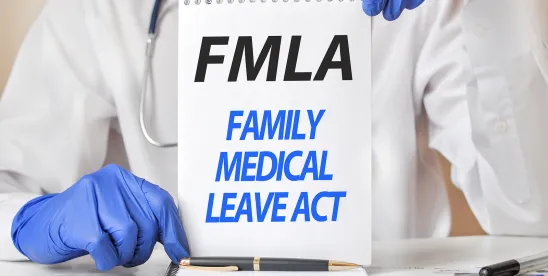The Family and Medical Leave Act (FMLA) provides important protections for employees with serious health conditions, and notice to the employer is required in order to trigger those protections. But what constitutes adequate notice? A recent case from the U.S. Court of Appeals for the Third Circuit provides guidance on this tricky issue.
Quick Hits
- Notice of the need for FMLA leave does not require specific language or explicit reference to the FMLA.
- Employers may want to ensure that managers and other administrative personnel who deal with leave and absences are trained to recognize when the FMLA might be in play and to record accurately the stated reasons for the leave.
- Employers cannot penalize employees for FMLA-protected absences.
Background On the Case
In Walker v. Southeastern Pennsylvania Transportation Authority,a former bus driver for Southeastern Pennsylvania Transit Authority (SEPTA), suffered from sickle cell anemia, which can flare up with severe pain. He had previously been approved for FMLA leave—once years earlier for complications related to his sickle cell anemia and again for several months during the COVID-19 pandemic because his condition placed him at risk. But the driver also had a history of attendance issues and, after accumulating a high number of points under SEPTA’s no-fault attendance policy, he was placed on a last chance agreement, under which his employment would be terminated if he reached twenty points.
The driver eventually accumulated eighteen points. He then experienced a flare-up of his sickle cell anemia. He called the dispatcher and informed her that he needed to go to the hospital and that he did not have a babysitter. The dispatcher wrote “NO_BABYSITTER” as the reason for his absence. Later that day, the driver submitted an application for FMLA leave. But, because his absence had been marked with an unprotected reason before he submitted his FMLA application, he accrued another two points, bringing him to the limit for which his employment could be terminated.
The driver called out again the following day for another flare-up that required another hospital visit, and he was out of work for two weeks. Meanwhile, SEPTA approved his FMLA application, retroactively to the first day that he called out, but left the points in place. Upon his return to work, the driver was told that he was being disciplined for his attendance violations. Although the union filed a grievance on his behalf to challenge the employment termination decision, the grievance was denied, and he was discharged.
The driver then sued SEPTA, alleging violations of his FMLA rights, among other things. He argued that SEPTA inaccurately recorded the reasons he provided for missing work. However, the federal district court found in favor of the employer, on the basis that the driver did not provide adequate notice about his need for FMLA leave. “There is no evidence that plaintiff’s termination was based on his … FMLA leave, or leave requests,” the district court stated.
The Rules of FMLA Notice
The FMLA entitles eligible employees to take leave for serious health conditions, but employees must provide their employers with adequate notice of their intent to take FMLA leave. As the Third Circuit emphasized in reversing the district court’s decision, the standard for FMLA notice is not particularly onerous. Key points about the FMLA’s notice requirements that the Third Circuit noted include the following:
- No magic words are required: Employees do not need to expressly mention the FMLA or use any specific language. The FMLA regulations only require that the employee provide “sufficient information for an employer to reasonably determine whether the FMLA may apply to the leave request.”
- Content of notice: The regulations provide that simply calling in “sick” is not enough. The employee must provide enough detail to alert the employer that the absence may be for an FMLA-qualifying reason. With regard to the current case, the court found that the driver’s statement that he had to go to the hospital, along with his submission of an FMLA application later that same day, could be deemed adequate notice by a reasonable factfinder. Even though the driver also said—and the dispatcher recorded—that he had no babysitter, that does not allow the other information to be ignored.
- Timing of notice: For unforeseeable leave, the regulations provide that notice must be given “as soon as practicable under the facts and circumstances of the particular case.” In the driver’s case, the court found that the timing of his sickle cell anemia episode was unpredictable, so he could not have provided earlier notice.
- No penalty for the use of FMLA leave: As the regulations provide, “[E]mployers cannot use the taking of FMLA leave as a negative factor in employment actions, such as hiring, promotions or disciplinary actions; nor can FMLA leave be counted under no fault attendance policies.” As the court noted, SEPTA granted the FMLA leave to cover the same day for which he was being disciplined, and “SEPTA could not legally penalize [the driver] for an absence that became FMLA leave before his firing.”
Next Steps
For employers, the court’s decision highlights the importance of training managers and other administrative personnel to recognize when an absence may qualify for FMLA and to document the reasons for absences accurately, particularly if the employee has a disability or an FMLA-covered condition known to the employer. When in doubt, employers may want to seek clarification from the employee.




 />i
/>i
